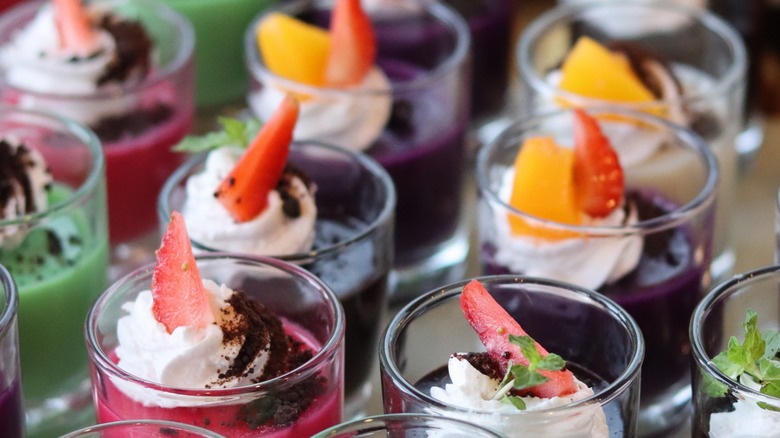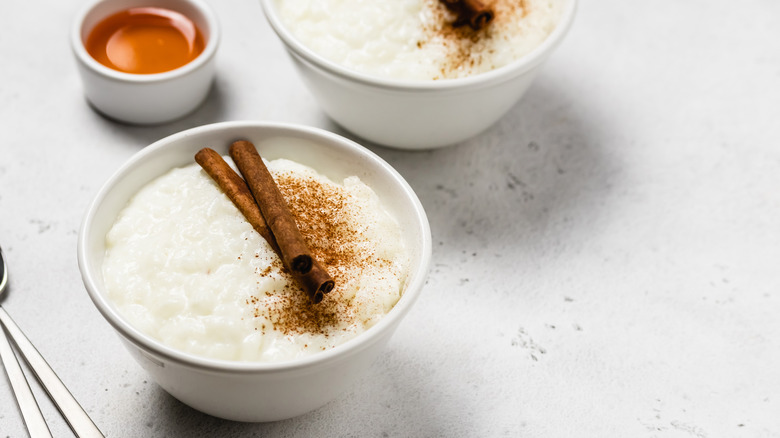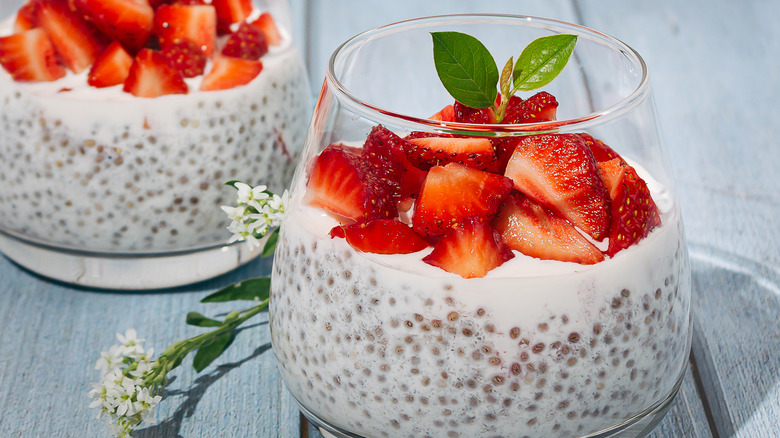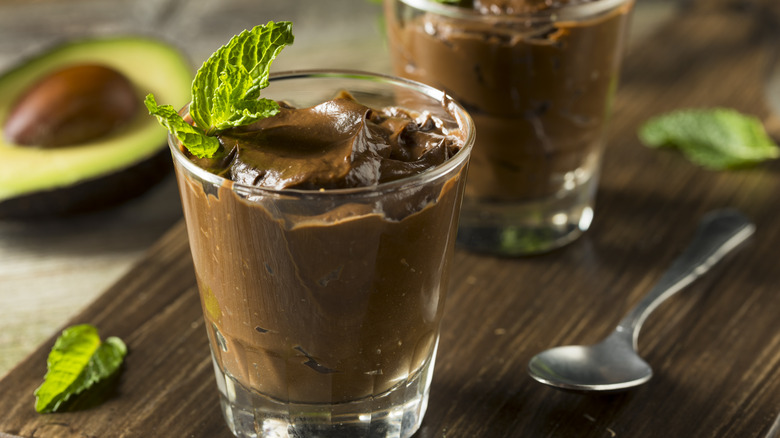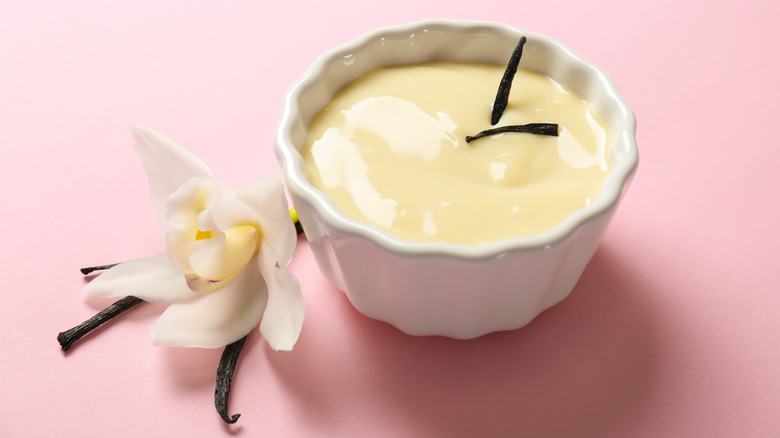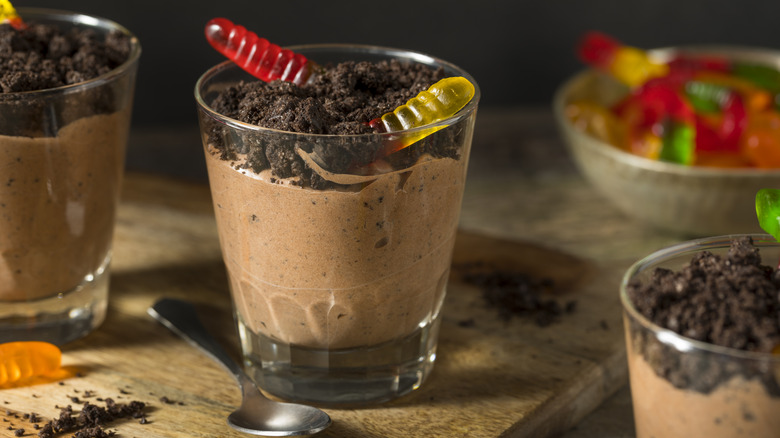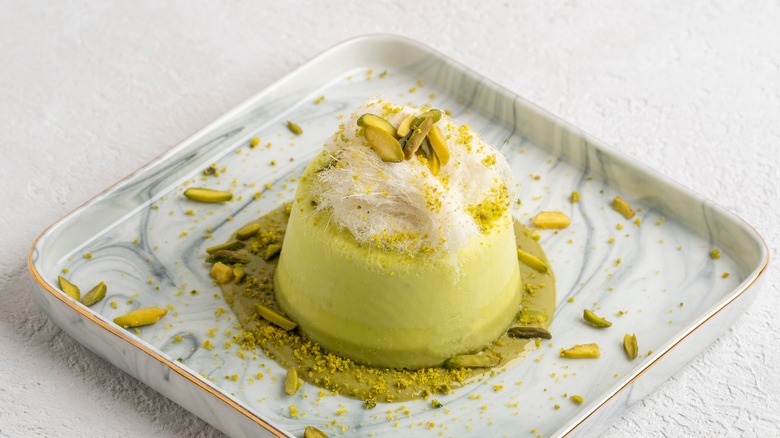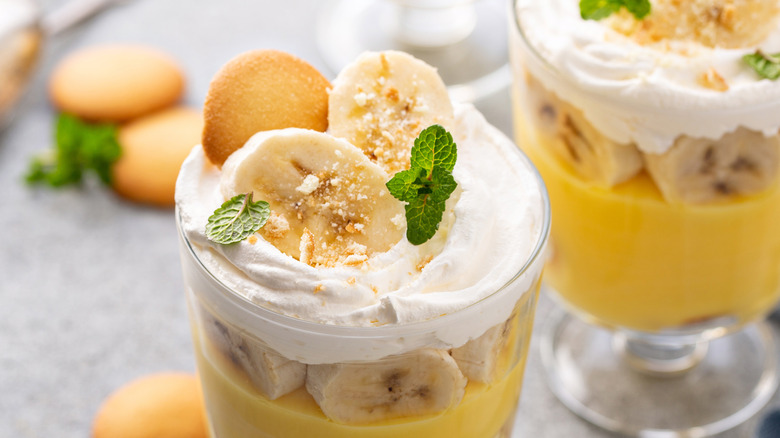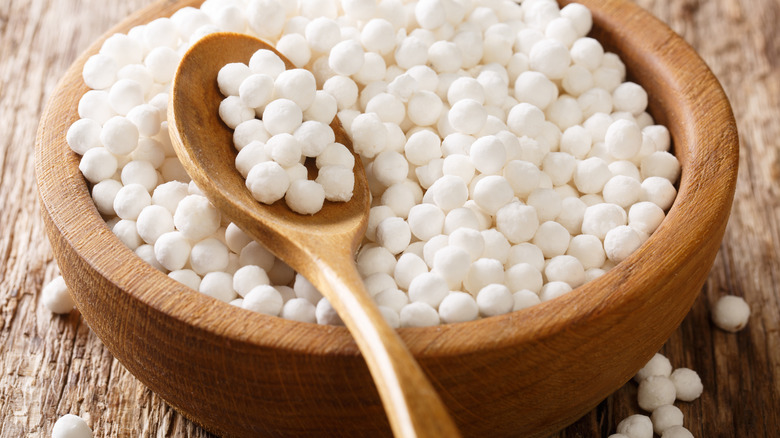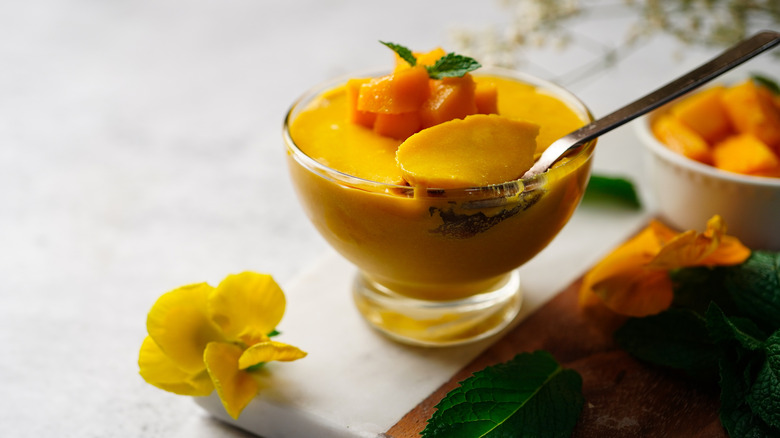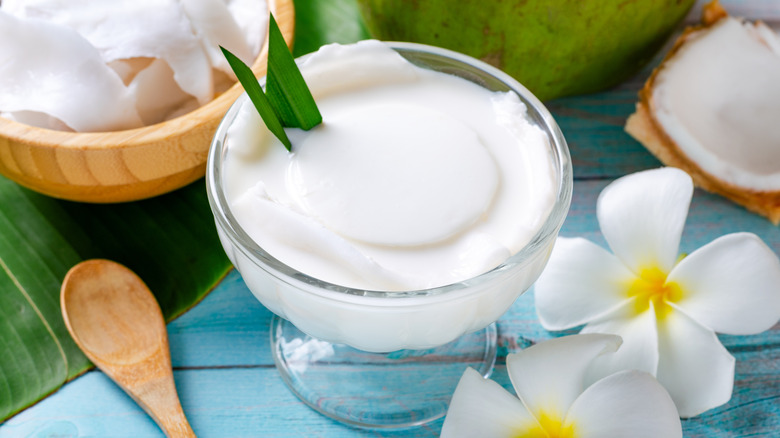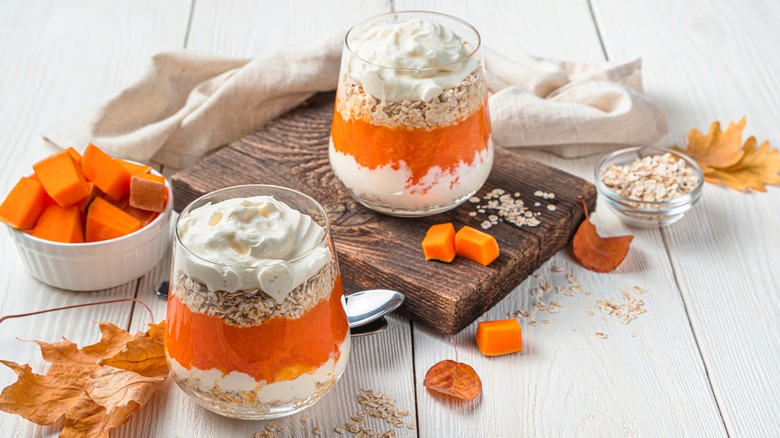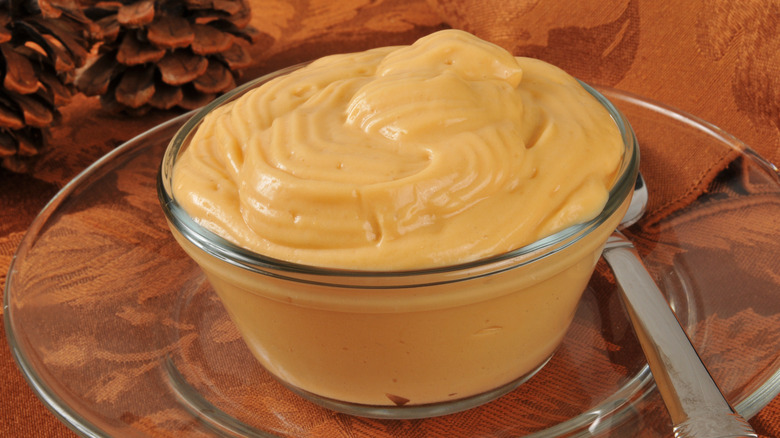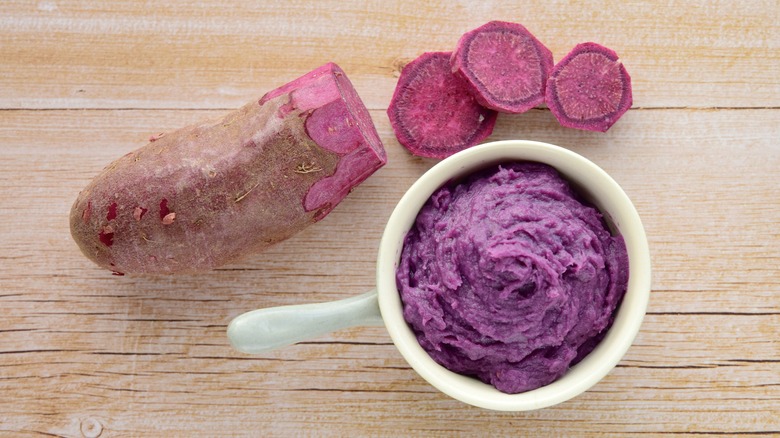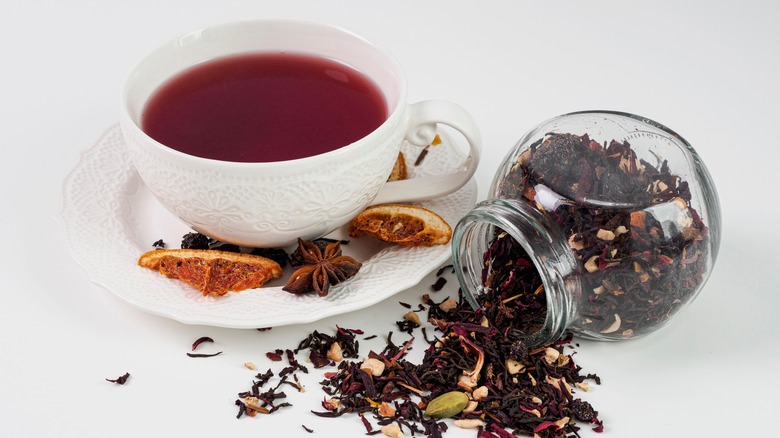15 Best Ingredients You Should Add To Pudding
Pudding is an enormously diverse but incredibly simple and foolproof dessert. American pudding (distinct from British pudding) is a dessert that is made from a mixture of milk or cream, sugar, and a thickener to give the pudding body. Pudding is similar to a custard, but unlike a custard, pudding does not always use eggs. The thickening agent for pudding can be either eggs or a starch such as flour or cornstarch.
During their preparation, any variety of ingredients can be added to enhance the texture and flavor of puddings. The mixture is then either boiled, baked, steamed, or chilled so that it sets. Once it achieves the desired consistency, pudding is served in a bowl and sometimes topped with whipped cream, chopped nuts, or berries. With so many available types of pudding, it can be difficult to narrow down your options. Read on for the best ingredients you should add to pudding.
Rice
Rice pudding has been around for centuries. Because it is so old, its origins are a bit murky, but one Ayurvedic grain pudding dish can trace its origins to 6000 BCE, and Roman pottages have been around since medieval times. In its current sweetened form, rice pudding can trace its roots as far back as the 15th century. Many cultures have some variation of this dish, from British rice pudding to Indian kheer to Turkish fırın sütlaç to Spanish arroz con leche. Each has its own unique flavor, but they're all uniformly delicious.
The starch in rice acts as a natural thickening agent for puddings, and the rice imparts a mild, subtle flavor that's gentle on the stomach and comfortingly nostalgic. The rice grains get soft in the pudding but still hold some of their shape, which creates a pleasant heterogeneity to the pudding texture. Rice pudding is also budget-friendly, as it's an efficient way to use up leftover rice.
Rice pudding is either cooked on the stovetop or baked in the oven, and it's often flavored with vanilla and cinnamon, and while it's delicious plain, it's also tasty with raisins or other sweet dried fruits added to the mix. Pistachios or almonds also make a beautiful accompaniment. The rice acts as the thickening agent, so eggs aren't required, but eggs can be added for an even richer rice pudding — Greek and Portuguese-style rice puddings often use eggs.
Chia Seeds
Chia pudding is a chilled pudding that doesn't require cooking to set. Instead, it exploits the natural viscosity of hydrated chia seeds to create a thickened, viscous texture. When they are exposed to liquid, chia seeds swell and exude a layer of mucilage around the seeds. Mucilage doesn't sound tasty, but it's actually almost flavorless, and it makes an outstanding thickener for a variety of foods, including puddings.
Chia pudding is popular because it's simple to make — you just mix ingredients together and let it sit overnight — and because chia seeds are a nutritional powerhouse full of protein, fiber, and heart-healthy Omega-3 fats. These attributes make it a healthy make-ahead breakfast. Chia pudding is also extremely versatile and works with any milk including cow's milk, oat milk, almond milk, and others. Chia seeds themselves have a fairly neutral flavor so chia pudding can be customized in a variety of flavors to suit individual preferences.
Avocado
Similar to chia seeds, mashed avocado can create a thick pudding-type dessert without cooking. The high-fat content present in avocados makes their flesh thick and buttery without the need for additional thickeners. Instead, avocados lend their creamy texture to a silky pudding packed with healthy fats, fiber, and nutrients.
Avocado pudding generally starts with combining mashed avocados, any type of milk, and a sweetener such as sugar, date syrup or maple syrup in a blender and pureeing the mixture until it's smooth. Some recipes call for freezing or refrigerating the mixture to make it firmer. Beyond this basic starting point, you can get inventive with your flavors. One of the most popular options is cocoa powder because the strong flavor masks the taste of avocados. However, vanilla, lime, banana and peanut butter, or pineapple are also tasty options. Or, if you're a fan of avocados, you can leave it unflavored and let the rich, lush flavor of the avocados shine through.
Vanilla bean
Old school and timeless, vanilla pudding is a standard for a reason: Just like with ice cream, pudding's creaminess serves as a perfect backdrop for vanilla's warm, fragrant floral tones. Vanilla pudding is one of the most popular flavors; in fact, it's so beloved there's even a National Vanilla Pudding Day.
Without a natural thickener like rice or avocado, vanilla puddings must use an added thickener such as eggs or cornstarch. They are also cooked — usually by boiling or steaming – rather than chilled to set. Use vanilla extract as a flavoring for your cooked pudding for an understated and satisfying dessert. You can also opt for vanilla bean paste or scraped whole vanilla beans to amp up the vanilla levels and add a more sophisticated finish. Vanilla bean seeds add visual interest to plain cream-colored pudding and a slightly grainy texture as well. Vanilla bean works best when it's kept simple, but you can also top it with almost anything: fruit, nuts, whipped cream, cookies, or candies.
Chocolate or cocoa
Chocolate pudding is about as classic as it gets. Cocoa's bitterness brings depth and complexity to the soft texture and sweet flavor of a traditional pudding base. It's no surprise that chocolate pudding is amongst the top pudding flavors eaten today.
There are many different varieties of chocolate pudding. Some are thickened with starch, while others — like French pot de creme — use egg yolks as the thickener. Chocolate pudding is faultless when enjoyed plain or can be enhanced with a light touch of mint, orange, or raspberry flavor. It also mixes well with spicier flavors like cayenne, chipotle, or cinnamon. Its dark color also contrasts nicely when it's layered with vanilla pudding or whipped cream in a parfait. Chocolate pudding can be served on its own, or it can be used as a filling for a decadent chocolate creme pie. Chocolate pudding makes a great frozen treat, too — just pour the pudding into molds and pop it in the freezer for chocolate pudding pops.
Dirt
To add some heterogeneity to the texture of your pudding, add crumbled creme-filled chocolate sandwich cookies atop chocolate or vanilla pudding. This combination is cheekily named dirt pudding because of the way the cookies look like dirt when they are crushed.
Since sandwich cookies already merge chocolate and vanilla flavors, they're a natural complement to either pudding flavor. You can use the original chocolate-vanilla cookie flavor or any variety of sandwich cookies. The cookies can be layered with the pudding parfait-style or swirled in throughout the pudding, but the layer on top is what gives dirt pudding its eponymous appearance.
There are a number of creative possibilities for visual effects using dirt pudding. Topping the dirt with candies like gummy worms or candy corn pumpkins can give it a spooky Halloween vibe. Some people use terracotta planters as cups and add plants like sprouts and succulents made from frosting to underscore the dirt-like appearance. Dirt pudding is a fun treat rich with imaginative possibilities.
Pistachos
Bright green, nutty and sweet, pistachio pudding is everything wonderful in the world. Pistachios contain a compound called benzaldehyde which gives them an almond-like flavor that anchors the sugary sweetness of any dessert they're in. Like all nuts, pistachios are high in fiber and protein, and while they're high in fats, it's healthy unsaturated fats.
Although it might be best known as a boxed pudding mix in the U.S., homemade pistachio pudding is absolutely worth the extra effort. Pistachio pudding's appealing soft yet vibrant green color comes from the natural color of pistachio nuts, which are finely ground before they're added to a classic cooked pudding. You can choose to leave it perfectly smooth or include some roughly chopped pistachios or almonds for a bit of textural interest.
In Middle Eastern cuisine, pistachios are sometimes added to puddings thickened with rice or rice flour along with rose water or cardamom, for example, in Turkish Muhallebi or Indian pistachio phirni.
Bananas
Banana pudding is an iconic Southern food in the U.S. It combines sliced or mashed bananas, layers of vanilla wafer cookies, and vanilla pudding into an indulgent and satisfying dessert. It's usually topped off with whipped cream and garnished with additional cookies. The original recipe for banana pudding dates back to 1878, when bananas were gaining popularity in the U.S., and it originally called for sponge cake rather than cookies.
In the 1920s, the cake was swapped for vanilla cookies, and that's the version that endures today. Sometime after World War II, banana pudding became closely associated with the American South. It's beloved because it's easy to make and it's an affordable way to serve a crowd, so it often makes an appearance at potlucks and other gatherings. The pudding softens and moistens the cookies so they turn almost cakey and add that essential textural interest to prevent a gloppy, boring pudding.
Tapioca
Another ingredient that thickens as it flavors is tapioca pearls. Tapioca pearls are translucent, edible spheres made from balls of starch from the cassava root. They come in a range of sizes from one to eight millimeters. They are gluten-free and vegan, which makes them an appealing choice for those on restricted diets. Tapioca pudding is similar in texture and flavor to rice pudding, but it has slightly fewer calories and fat than rice pudding.
Tapioca pearls are soaked until they become gelatinous and added to a cooked pudding. The starchiness of the cassava root thickens the pudding. The tapioca pearls retain their shape even after being soaked and cooked, so they add an appealing chewy bubble texture to the finished product.
Tapioca pearls don't have much of a flavor on their own, so tapioca pudding can be flavored with almost anything. Popular options for tapioca pudding are vanilla, mango-coconut, dulce de leche, and blueberry-lemon.
Mango
Bright and luscious, mango is a popular pudding flavor worldwide. Mango is naturally sweet so mango pudding uses less added sugar than other pudding flavors. Although it's very sweet, mango has enough tartness to it to keep it from becoming overly sweet or sickly. Sometimes, citrus juices are added to increase the tartness. It's frequently made with coconut milk for a tropical and refreshing summertime snack, and may also be made with sweetened condensed milk.
Mango pudding gets a double dose of fruity goodness with mango puree mixed into the pudding base and the finished pudding topped off with mango chunks. In the Asian version of mango pudding, mango sago, the pudding gets its body from sago, an ingredient similar to tapioca but derived from the pith of the sago palm. The sago thickens the pudding and adds texture to the finished dessert. Mango sago is enjoyed in China, Malaysia, Singapore, and other Southeast Asian countries.
Coconut milk or cream
Particularly popular in warm, tropical regions, coconut pudding is a light, refreshing take on dairy pudding. Coconut milk pudding needs a thickening agent in order to set, so cornstarch is an important ingredient. The corn starch is such an effective gelling agent that coconut milk pudding is usually set in a mold for beautifully shaped results. It sets so firmly the texture is almost like gelatin. It can be unmolded and retain its shape or sliced into elegant squares for individual servings.
The Hawaiian version of coconut pudding, known as haupia is a celebratory food featured at luaus. It can also be sliced into cubes and used as a topping for other foods. In Brazil — where it's a traditional New Year's Eve food — coconut pudding is known as manjar branco and may include shaved coconut, dried fruit, or plum sauce. In Puerto Rico, this holiday coconut milk pudding is called tembleque and is commonly dressed with fruit, juice, liqueur, or spices.
Pumpkin puree
Pumpkin pudding is an even richer, more decadent spin on the quintessentially seasonal pumpkin spice latte. It's a great way to use up leftover pumpkin puree from holiday meals or from an over-abundant fall garden. Pumpkin puree gives a pulpy, fluffy texture to the pudding and adds a hearty helping of fiber to boot. In pumpkin pudding, a standard baked or boiled vanilla pudding gets a measure of pumpkin puree and baking spices, which may include cinnamon, allspice, ginger, nutmeg, and cloves. These warming fall seasonings perk up bland pumpkin, and their spicy bite balances against the pudding's creamy lusciousness.
Pumpkin pudding can be further enriched by using evaporated or condensed milk instead of regular milk. These more concentrated types of milk add a richer, more caramelized sweetness. Take it a step further by using brown sugar as the sweetener to bring in some depth from the robust flavor of molasses. Top it all off with whipped cream to take it to the next level of autumnal bliss.
Butterscotch or caramel
Butterscotch and caramel are both gooey sweets made by cooking sugar until the sucrose molecules break down and the sugars darken, thicken and gain a complex, toasted quality. The key difference between butterscotch and caramel is the type of sugar used. In caramel, it's white sugar, but for butterscotch, it's brown sugar. Cream or butter is often added to affect the consistency of the caramel or butterscotch, and frequently a dash of salt amplifies the flavor profile. Caramel can be used in a ton of different ways, but caramel or butterscotch pudding is a winsome combination; Salty-sweet and extremely habit-forming, no one can resist it.
Butterscotch or caramel can either be mixed directly into the pudding, drizzled on top of it, or swirled throughout another pudding flavor. There are limitless variations of caramel pudding, including salted caramel budio, dulce de leche pudding, Croatian rozata, or the tried and true butterscotch.
Ube
Ube (Dioscorea alata) is a yam native to the Phillippines, which has a creamy vanilla flavor to it and a striking bright purple hue. Not to be confused with purple sweet potato, yams such as the ube in fact belong to a different genus (Dioscorea) than sweet potatoes (Impomoea). Ube has been used in Filipino desserts for many years, but recently it's gained popularity worldwide. As bakeries have started adding it to cheesecakes, ice creams, flans, and puddings it has been embraced by diners the world over.
As a yam, ube is large and tough so it must be peeled, chopped and boiled or steamed before it's added to a pudding. The starch in the cooked, mashed ube thickens the uncooked pudding as it takes on the ube's color. Ube's appeal goes beyond its dazzling appearance, it also has a distinctive, complex yet subtle taste. If you haven't yet tried this screaming violet tuber, you definitely should.
Tea
Tea is an unexpected ingredient to add to pudding, but it works really well in practice. Is there anything as comforting as a cup of tea? Combine tea with pudding — another comfort food — and the results are extraordinarily soothing. The sharp tannins of tea counter the milky creaminess of pudding, and teas are a ready-made symphony of flavors. It's like an extra creamy tea latte with more heft and body.
To flavor a pudding with tea, use a small amount of brewed tea as well as unbrewed tea leaves for extra punch. Limit how much of the brewed tea you use, or it will make the pudding too watery. Try it with Earl Grey for a whisper of bergamot with the black tea flavors, or go bolder with chai tea's strong ginger, cardamom, pepper, and cloves. Green tea or matcha tea also works well for a grassy, herbal take on dessert.
